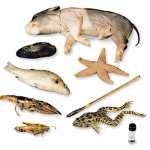Zoology
|
3 may 2015 13:33:08 |
| Clinical and pharmacokinetic evaluation of S-ketamine for intravenous general anaesthesia in horses undergoing field castration (Acta Veterinaria Scandinavica) |
|
Tweet Background:
Intravenous anaesthetic drugs are the primary means for producing general anaesthesia in equine practice. The ideal drug for intravenous anaesthesia has high reliability and pharmacokinetic properties indicating short elimination and lack of accumulation when administered for prolonged periods. Induction of general anaesthesia with racemic ketamine preceded by profound sedation has already an established place in the equine field anaesthesia. Due to potential advantages over racemic ketamine, S-ketamine has been employed in horses to induce general anaesthesia, but its optimal dose remains under investigation. The objective of this study was to evaluate whether 2.5 mg/kg S-ketamine could be used as a single intravenous bolus to provide short-term surgical anaesthesia in colts undergoing surgical castration, and to report its pharmacokinetic profile.
Results:
After premedication with romifidine and L-methadone, the combination of S-ketamine and diazepam allowed reaching surgical anaesthesia in the 28 colts. Induction of anaesthesia as well as recovery were good to excellent in the majority (n = 22 and 24, respectively) of the colts. Seven horses required additional administration of S-ketamine to prolong the duration of surgical anaesthesia. Redosing did not compromise recovery quality. Plasma concentration of S-ketamine decreased rapidly after administration, following a two-compartmental model, leading to the hypothesis of a consistent unchanged elimination of the parent compound into the urine beside its conversion to S-norketamine. The observed plasma concentrations of S-ketamine at the time of first movement were various and did not support the definition of a clear cut-off value to predict the termination of the drug effect.
Conclusions:
The administration of 2.5 mg/kg IV S-ketamine after adequate premedication provided good quality of induction and recovery and a duration of action similar to what has been reported for racemic ketamine at the dose of 2.2 mg/kg. Until further investigations will be provided, close monitoring to adapt drug delivery is mandatory, particularly once the first 10 minutes after injection are elapsed. Taking into account rapid elimination of S-ketamine, significant inter-individual variability and rapid loss of effect over a narrow range of concentrations a sudden return of consciousness has to be foreseen. |
| 155 viewsCategory: Medicine, Zoology |
 Detection of the neuropathogenic variant of equine herpesvirus 1 associated with abortions in mares in Poland (BMC Veterinary Research) Detection of the neuropathogenic variant of equine herpesvirus 1 associated with abortions in mares in Poland (BMC Veterinary Research)Wound care antiseptics - performance differences against Staphylococcus aureus in biofilm (Acta Veterinaria Scandinavica) 
|
| blog comments powered by Disqus |
MyJournals.org
The latest issues of all your favorite science journals on one page
The latest issues of all your favorite science journals on one page



